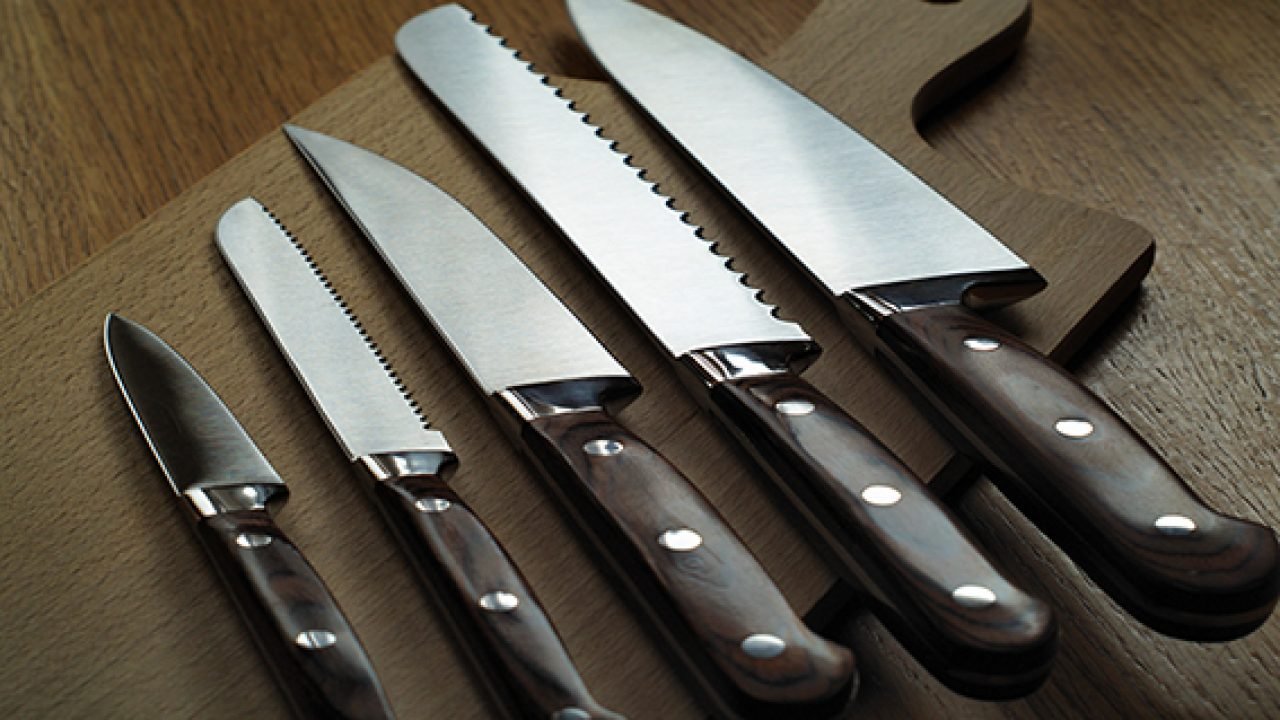Whether you are a top professional chef, an enthusiastic home cook, or a kitchen beginner who is still learning their way around the kitchen, a top quality set of kitchen knives will be your best friend in the kitchen, with a well balanced, high precision knife being an essential tool as you get chopping up a range of delicious dinners.
However, not all knives are made equally, and very few people know that different types of kitchen knives exist, each having a distinctive use and purpose.
So in today’s article, we are going to be explaining the essential selection of knives that every budding chef should have in their collection to perform everyday tasks as we aim to give you the right knowledge that will give you extra confidence when approaching kitchen chopping action of any variety.
Chefs Knife
The undoubted king of versatility in any kitchen is the Chefs knife. A good quality chef’s knife is the perfect tool for a wide array of kitchen tasks, and whether you are dicing, slicing or roughly chopping, your chef’s knife will likely provide you with a perfect balance of size and functionality.
The design of a chef’s knife, particularly in how the blade tapes to a sharp point, means that it is a great knife for precision cutting, whilst also being able to withstand bulkier and rougher action due to the broad heel area of the blade.
Although sizes can vary, a typical chef knife blade usually measures in at between 8 and 10 inches, with the largest models tipping the ruler at up to 14 inches. The key to mastering action with your chef’s knife is to work with a model whose size and weight you feel comfortable with.
It is not uncommon for those just starting out in the kitchen to be slightly intimidated by the size of a chef’s knife, however, this usually eases with practice, and the chef’s knife proves to be a perfect all-rounder for everyday use.
Santoku Knife
If the chef knife is the king of the kitchen, then the Santoku knife is the next in line to the throne. With a name taken from the Japanese word santoku bocho, which means ‘having three uses’, Santoku knives originate from Japan, yet are becoming increasingly popular in western kitchens
They are distinctive from chef knives in a couple of ways. Firstly, they are usually smaller than the average chef’s knife, often measuring in at between 5-8 inches.
The second distinctive feature is the way in which the blade is shaped, with Santoku knives lacking the tapered point of more common chef knives. This means that the knife is used less for “rocking” type of chopping, and instead is best utilised by cutting down in a single decisive motion. The blade style and thinner form of Santoku knives mean that it is easier to achieve super fine precision slicing.
Bread knife
With chef knives and Santoku knives being versatile all rounders, the next on our list is a tool that has a much smaller area of expertise. This is the humble bread knife.
Bread knives are easily spotted, and can be identified by their long thin serrated blade. This design is unique when it comes to kitchen knives, and some people say that it resembles a saw more than a knife! The design however is key to its utility, with each sharp ridge of the blade applying pressure to the object from a variety of angles. This means that bread knives are better suited at slicing through soft foods without ripping or squashing them, perfect for maintaining the shape of a variety of items such as breads, pastry and cakes.
Although bread knives are a little tricky to sharpen, they do stay sharp for longer, meaning that sharpening will be required much less often than with other straight bladed knives. A word of warning though. The sharpness and design means that as well as sawing through bread, these knives are also great at sawing through fingers….so be careful and use with caution!
Serrated knife
We have already covered the bread knife on this list, however you may be surprised to realise that bread knives are not the only type of kitchen knife that utilises a serrated blade.
Sometimes called a tomato knife, these small serrated utility knives are a useful tool to keep in your kitchen collection, as they are ideal for use on smaller bread items, as well as foods with a delicate skin and soft interior such as tomatoes.
Cleaver
Cleavers are the biggest and baddest knives found in most kitchens, and are distinctive in that they have a large, flat, rectangular-shaped blade, making them not only the biggest, but also the heaviest knife you are likely to have in your kitchen.
As the name suggests, the size of a cleaver is perfect for chopping raw meat as part of the butchering process, with its size and weight allowing the tool to easily smash through the toughest meat and even bone.
Carving knife
With a clever being the go to tool for raw meats, a carving knife is the undisputed go to blade for slicing cooked meats.
With their narrow blade that forms a pointed tip, Carving knives are perfect for carving up your Christmas Turkey or Sunday roast. The design of the blade means that a carving knife provides less resistance than other types of blades, which allows chefs to slice meat in a thinner and more uniform manner.
Although perfect for slicing cooked meats, carving knives are not designed for chopping items that are too tough, and are most at home in executing long slices in a single smooth motion.
Boning knife
Another must have knife for those working with meat is a boning knife. Whereas a cleaver is used to chop larger pieces of meat, a boning knife is a smaller, more intricate knife that features a shorter, skinny, yet very sharp blade that tapers towards its pointed tip.
A cleaver will smash through bones, however a boning knife will cut around them, with its design providing the perfect shape and utility to trim meat and fat from bones without destroying the flesh of the meat.
The strong, rigid blade can also be used to cut through cartilage and boning knives are designed to be both light and manoeuvrable, meaning that you can count on them to be comfortable and easy to use.
A cousin to the boning knife is a filleting knife. These look very similar to boning knives, yet have a thinner flexible blade, which is commonly used to fillet fish.
Although not as versatile as a chef’s knife or cleaver, boning and filleting knives are essential for those cooks who work with meat and fish, providing a precision that makes working with these items much easier.
Paring knife
The ubiquitous paring knife is one of the staple tools for any kitchen. Coming in a variety of shapes and sizes, paring knives have either a straight, curved or claw-shaped blade, which is ideal for precision cutting. Measuring in at around 3-4 inches long, these versatile knives are at home peeling and chopping fruit and vegetables.
Paring knives may be small in size, but what they lack in size, they make up for in versatility, and can be used for a multitude of kitchen tasks. Despite their small size, paring knives will make light work of harder foods, like potatoes, while still being manoeuvrable enough to carry out delicate tasks like peeling, trimming, and removing seeds from fruit and veg.
Utility Knife
Bridging the gap between the large chef’s knife and the smaller paring knife, a good quality utility knife is perfect for chopping smaller foods and vegetables, such as shallots and onions. Although the form and shape resembles a chef’s knife, they are much smaller in size, measuring in between 4-7 inches, making them a useful tool for when working with smaller food items, giving a little better handling than a chef’s knife for tasks like coring, trimming, and deboning.
Butchers knife
Related to a meat cleaver, a butcher’s knife is good for chopping and slicing up chunks of meat. The downside is that it offers less precision than a cleaver, meaning that butchers knives are not so common to find in a home kitchen, but rather, are more likely to be seen in niche commercial kitchens that work with meat on a larger scale of quantity.
Salmon Knife
Another less popular, more niche, product is a salmon knife. Salmon knives are distinctive because they have a very long and flexible blade, usually with a double edge, meaning that they are perfect for filleting and removing skin from larger fish such as salmon. They prove perfect for this job due to the fact that they are slender enough to fit between the skin and flesh without damaging the delicate fish, meaning that the chef is able to achieve clean and tidy fillets. allowing the chef to create clean, tidy fillets. It is very uncommon to see this type of knife in a home kitchen, and with these usually seen in commercial kitchens that specialise in fish.
Although we have covered the most common types of knives that you will need to know about in the kitchen, perhaps more important than the type of knife you use, is the need to keep them sharp and well maintained.
A sharp and well looked after knife is much safer to work with than a blunt knife, so you will need to ensure that whatever knife you are using is in top condition, which will not only make your life easier, but will also be key in prolonging the life of the blade.
We hope that you have found this article useful. Whatever your preference and star pick is, it is clear that a set of professional chefs knives will help to ensure that food preparation in your kitchen is safe, efficient and easy, and it will even improve the quality of your dishes. Happy chopping!

